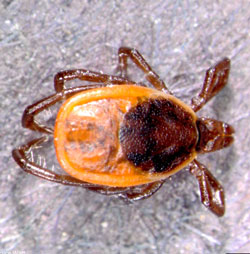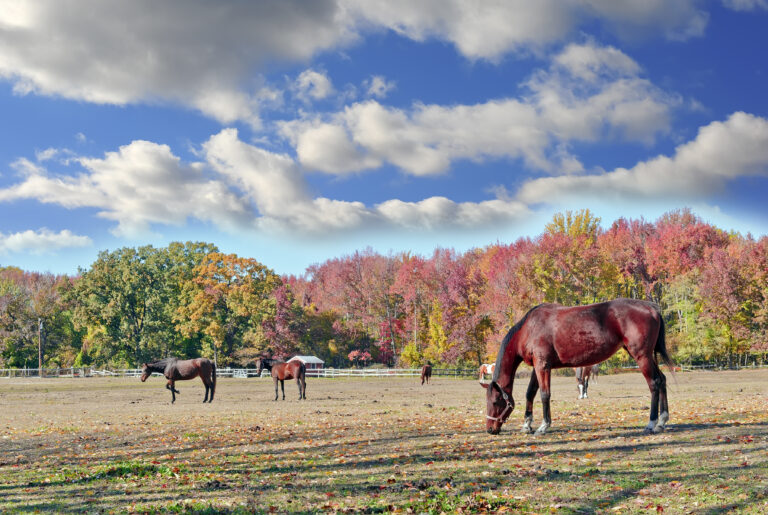Why should horse owners be concerned about ticks? You can learn more from Dr. Erika Machtinger in this podcast episode. She is an Associate Professor of Entomology in the Department of Entomology at PennState College of Agricultural Sciences. She has a Masters and a PhD in entomology.
More Than a Nuisance
Ticks are more than a nuisance, said Machtinger. “They can cause some real problems for horses,” she said. “When they bite, they can irritate the skin. That irritation can lead to itching, rubbing, hair loss, and a heavy infestation can lead to anemia in some animals, especially older ones who may be a bit more compromised.
“And beyond this irritation, the biggest concern we have with some ticks is that they’re carriers of pathogens that can cause diseases,” Machtinger continued.
U.S. Equine Tick-Borne Diseases

In the U.S., the tick-borne illnesses of greatest concern to horses are Lyme disease and anaplasmosis, said Machtinger. “Those are the same ones that we’re the most concerned about from a human perspective, as well. So humans, horses, and dogs are all susceptible,” she said.
Those diseases are most common in the Northeastern United States, in the Midwest, and in parts of the Mid-Atlantic, said Machtinger.
“We don’t see them across the entire United States. But you move your horse places around the country, so you have to be aware of those risks,” she added.
Global Equine Tick-Borne Diseases
One of the most important global equine tick-borne diseases is piroplasmosis. Machtinger said it’s most common in Central and South America, the Caribbean, and parts of Asia, Africa, and Australia.
“Our friends in Australia have a really interesting condition where horses can suffer from tick paralysis from the bites of a very specific tick,” said Machtinger. “People can suffer and other animals as well. It’s a reaction to the saliva that the ticks have. It’s not common in the U.S. at all, and some other places in the world can have it, but it’s definitely one that pops up there every once in a while.”
Asian Longhorn Tick

The longhorn tick was introduced to the U.S. around 2017, she said. “There’s some indications it was here a little before that, but it’s really when we started to identify it and track it. Obviously it’s invasive, and I do expect we’re going to see more coming to the U.S. and potentially U.S. ticks moving to other places.
“The longhorn tick is unique because females are parthenogenetic, so they do not need a male to mate. They just create clones of themselves,” explained Machtinger. “They can lay thousands of eggs without mating. So, that means populations can explode quickly, and you only need one female to start a population.
“It feeds on a wide range of animals,” she continued. “It does prefer things with hooves, but it gets around on wildlife just fine.”
In other countries, this tick has been associated with pathogen transmission in livestock and humans. Machtinger said these ticks have been found on horses in Pennsylvania.
Entomologists are not sure what the risks are to U.S. horses, said Machtinger. She said a concern is the sheer number of ticks that can bite an animal and cause stress and blood loss.
“A lot of the the cattle that we see with this tick in high numbers, if they’re passing away, it’s often from a secondary condition. The ticks cause the stress, then something else happens and it causes them to die.”
Right now, the tick is pretty limited to the eastern part of the United States, but it is popping up in new areas every year.
Environmental Precautions
Keeping horses away from brush and scrub can help prevent ticks from climbing on the animals. Machtinger said regular tick checks are important for removing ticks as soon as possible. She said pay special attention to the mane, tail, and between the legs.
Tick life cycles can vary in different parts of the world. “Our blacklegged tick, which is associated with Lyme disease and anaplasmosis, is common on horses in the spring and fall in the eastern part of the United States,” said Machtinger.
She said just like planning for vaccinations, owners should plan for tick control based on life cycles. “You have to know when it is tick season and plan head for treatments,” advised Machtinger.
New World Screwworm
Because New World screwworm (NWS) has been in the news, we asked Machtinger about this pest.
“The problem with this fly is that its larvae feeds on living tissue, so it’s basically eating the animal alive once it is infested,” she said.
The United States had eradicated NWS decades ago, but the insects are moving into the United States from the Mexico border. “And there is a risk people, other animals, and livestock can bring the fly back when traveling,” she advised.
Machtinger said this fly can can invade any wound, including a tick bite, a cut from a fence, an insect bite, or a scratch. “It can lead to these really painful infestations if not treated correctly and quickly,” she said. “Fly awareness is really the key. Especially if you have a horse that travels internationally or even to the southern states and back up north.” This is true of horses and other livestock such as cattle. She advised to keep an eye on any open wounds.
Further Content
- Tick-Borne Diseases of Concern in U.S. Horses. MySeniorHorse.com
- Daily Tick Checks on Horses Reduces Risk of Disease. Dr. Nancy S. Loving. MySeniorHorse.com
- Equine Insect Repellents for Horses. Dr. Nancy S. Loving. MySeniorHorse.com
- 6 Tips to Decoding a Fly Spray Label. MySeniorHorse.com
- 8 Health Issues for Horses in Summer. MySeniorHorse.com
- Using the ‘CRAAP’ Test to Decipher Senior Horse Information. Dr. Janet Douglas. MySeniorHorse.com
- Insect Management on a Horse Property. Dr. Nancy S. Loving. MySeniorHorse.com
- New World Screwworm Threat. MySeniorHorse.com
Sign up for My Senior Horse’s FREE newsletter to get the latest information about equids 15 years and older delivered straight to your inbox!
-
View all posts
Kimberly S. Brown is an award-winning writer and publisher. She is the Editorial Director for My Senior Horse. Brown spent 10 years at Equine Network, parent company of My Senior Horse. Prior to that she worked for three years in equine nutrition after she retired from nearly 30 years working at The Blood-Horse. Brown spent the last 15 years of her time at that organization creating and developing The Horse and TheHorse.com.











